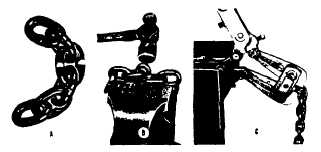Figure 13.
CUTTING LOAD CHAIN
REMOVAL AND INSTALLATION OF LOAD CHAIN
Hoist load chain can be installed by any one of
several methods. The first method is recommended
when replacing severely worn load chain and requires
disassembling the hoist. Method 2 does not require
hoist disassembly, whereas Method 3 requires only
partial disassembly.
NOTE: When installing load chain in Models E,
H, R, RR, E-2, H-2, R-2 and RR-2 by either of the
"starter chain" methods, two loose end connecting links
S-743 must be used.
Method #1
a)
Disconnect hoist from power supply.
b)
Remove back frame cover and disengage the
limit switch guide plate from the traveling nuts,
see page 16.
c)
Detach loose end of load chain from hoist
frame, see Figure 2. Also on single chain
models, detach the lower hook block from the
load chain.
On double chain models E, H, R, RR, E-2, H-2,
R-2 and RR-2, unfasten the dead end side of
load chain.
d)
Continue to disassemble the hoist and inspect
the liftwheel, chain guides, motor housing and
gear housing which if worn or damaged could
cause early failure of the new chain. Parts can
be easily identified by referring to pages 29 and
31.
e)
If the liftwheel pockets, in particular the ends,
are worn or scored excessively, replace
liftwheel. If chain guides and housing are worn
or cracked, these parts should also be replaced.
f)
Reassemble hoist with the new load chain
inserted over the liftwheel. Position chain with
the weld on upstanding links away from liftwheel
and leave only one foot of chain hanging free on
loose end side. Make sure the last chain link is
an upstanding link and on double chain models
that the new load chain has an even number of
links. This will help prevent resulting twist in
chain.
To simplify handling when reassembling the
hoist, a short undamaged piece of the old chain
may be used as a "starter chain". Position this
piece of chain in exactly the same manner as
explained above for the "new chain" and
complete the reassembly of the hoist.
15
g)
Attach the loose end link to chain and connect it
to the hoist frame with the loose end screw,
washer and lockwasher, see Figure 2. BE
SURE THERE IS NO TWIST.
If a starter chain is used, the loose end link (two
links required for double chain models) can
serve as a temporary coupling link to connect
together the starter chain in the hoist and the
new load chain to be installed. Then, under
power, reeve the new load chain through the
liftwheel area, replacing the starter chain in unit.
Run enough chain through to attach loose end
link to hoist frame.
CAUTION: For double chain models, be sure to
disconnect one of the loose end links from load
chain before attaching to hoist frame.
h)
For single chain models, attach the hook block
to load chain and proceed to step m.
For double chain models, run the hoist r (UP)
until only 3 feet in chain remains on (lead end
side. This will minimize the chance of
introducing a twist between hook block and
hoist.
Replace chain with CM "Star" load chain of the
appropriate size, embossed with * on side of
barrels at intervals of approximately 19 inches.
i)
Allow the chain to hang free to remove twists.
j)
Using a wire as a starter, insert the chain, flat
link first, into lower hook block (upstanding links
will have weld toward sheave) and pull through.
k)
Insert last link into slot in dead end block
making sure that no twist exists in the reeving at
any point.
l)
Assemble dead end pin, washer and cotter pin
as shown in Figure 2.
m)
Adjust limit switches as described on page 16
and 17. If the new load chain is longer than old,
check to be sure limit switch will allow for new
length of lift. In the event maximum adjustment
does not allow entire length of lift, check with
the factory for modification necessary.
Do not allow hook block to hit hoist nor allow
load chain to become taut between loose end
screw and frame or else serious damage will
result. If hook block should inadvertently hit the
hoist the hoist frames, load chain and hook
block should be inspected for damage before
further use.
Method #2
Treat the old load chain in hoist as a "starter
chain" and proceed with Steps la, b, c and f thru
m above.
Method #3
a)
First proceed with Steps la, b, c above.
b)
Then, carefully run the load chain out of hoist.
c)
Disconnect hoist from power supply.
d)
Remove the electric brake assembly.
'e)
Rotate the brake hub by hand, at the same time
feeding the load chain into and through liftwheel
area with hoist upside down or using a wire to
pull
the
load
chain
up
onto
liftwheel.

